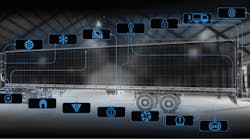The trucking industry is faced with several problems of growing proportions. From the driver and technician shortage to continued increasing complexities of equipment in our ever-changing industry. As we look to develop solutions to the problems our industry faces, the adoption and move to smart connected technologies is needed. An analytical end user interface that prescribes solutions to those problems will be a key enabler.
Increasing demands have led to a need for higher utilization rates, leading to higher demand for an accelerated level of assessing and repairing equipment issues. Connect this to rising operational costs in the commercial vehicle industry, as noted in the American Transportation Research Institute’s (ATRI) most recent Analysis of the Operational Costs of Trucking: 2018 Update, and there are many problems to solve.
Evolution of the process
The Internet of Things (IoT) has enabled unforeseen connectivity across vehicle platforms like never before. The value of data coming from sensor-equipped componentry can now be accessed from a device or computer miles away, and decisions can be made on the spot with little to no human interaction.
What began with the U.S. military as early as 1982, with the process of connecting simplified test equipment for internal combustion engines (STE/ICE) to a diagnostic connector assembly (DCA), has now evolved into the process of over-the-air diagnostics and programming. In some deep, dark corner still lies the ProLink with its multiple cartridges that were used to plug into some of the first sensor-equipped electronic engines.
Instead of waiting to plug into a vehicle to grab the vital statistics to perform diagnostics, soon fleets will simply review alerts and artificial intelligence (AI) algorithms will use all the data – historical and current – to prescribe a repair, as well as advise on the location of the closest available part needed for the repair. The system will then communicate that information to both ends of the repair spectrum and even build the repair order prior to arrival.
What makes equipment “smart?”
Smart equipment talk is everywhere, from smart trucks to smart trailers to smart components.
What exactly is "smart?" Sensorization of componentry has created complex individual equipment networks allowing for collaborative alerts and streams of data enabling machine learning to occur. This machine learning, coupled with AI historical data from computerized maintenance management systems (CMMS) and transportation management systems (TMS), transforms the previous method of plugging into the asset to find out an issue, into a self-reporting and diagnosing asset. That asset that can self-report is smart.
Think of this network like a human body, where the brain is the ECM and every nerve is a sensor – one totally connected network that works together and collaborates based on the messages they send. Even machine learning can be compared to a person’s individual learning experiences. You yourself are also the end user and decide the course of action instantaneously, or seek a professional for a prescribed solution.
The continued evolution
E-commerce and the quest for complete visibility of delivery is being driven by consumers. Our quest for instant gratification is changing how products and services are being provided today and will continue to change the future of how we think and do fleet maintenance. There is talk of smart cities, electric vehicles, and autonomous vehicles in the news every week. Smart really started with the first telematics system and now has moved to traffic prediction, terrain and weather mapping, intelligent transportation systems (ITS), and social media integration. It continues to evolve every day.
The demand for vehicle-to-vehicle (V2V) and vehicle-to-infrastructure (V2X) communications that provide actionable data and information will continue to accelerate change, as well as prescriptive maintenance solutions that prevent costly occurrences in a fleet’s network.
The impact on maintenance
Current maintenance practices are time- or mileage-based. While most make component replacements based on a pre-determined pull point, sometimes a replacement occurs only after a component has failed. When breaking down maintenance, it basically divides into two main categories: scheduled or unscheduled.
One can assume that an unscheduled repair is more costly than a scheduled, controlled repair. The unscheduled event can occur anywhere and involves much more than just the cost for the component, labor, or even a tow. Most times, drivers are involved in this unplanned event and the cost to move around equipment, drivers, and the recovery of any of the above end up eating into profit directly.
The other problem is that no warranty covers this additional loss while out on the road, including missing a tight delivery window. In a worst-case scenario, an unscheduled repair could shut down a manufacturing plant or cause a fleet to lose a customer, in the end leaving a long-lasting drain on the operation and reputation.
Imagine how great it would be under constant monitoring where prescriptive action is taken to avoid any unplanned downtime. Connectivity, uptime, safety, big data analytics, and visibilityn will be the key technology focal points as the industry moves into the equipment needed for tomorrow’s technologies and demands of today.
Innovation will be driven by regulation and the need for greater visibility, coupled with efficiency, to combat the industry’s issues. The heart of connectivity is telematics and smart sensor-equipped components on one data plan that will enable a more efficient maintenance approach.
Technology gives today’s business the power to not only predict failures, but it allows them to proactively prescribe a corrective course of action and use that information to streamline business practices. Keep in mind that prescriptive maintenance is much more than using past histories to make assumptions of what will happen in the future. Big data analytics assesses the operational characteristics of a fleet’s equipment and determines a path to prevent unplanned costly maintenance. That is a drastic change from the fix-as-fail unplanned events to a fix-as-prescribed planned event.
A well-maintained vehicle is a safe vehicle that is also a reliable vehicle. Not only does this increase equipment availability, but it also saves time and money.




